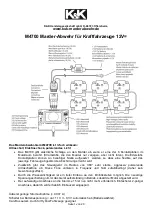
61
2004 L/C100 from Aug ’03 Prod. (OM60A04U)
The front airbag sensors constantly moni-
tor the forward deceleration of the vehicle.
If an impact results in a forward decelera-
tion beyond the designed threshold level,
the system triggers the airbag inflators. At
this time a chemical reaction in the inflat-
ors very quickly fills the airbags with non
−
toxic gas to help restrain the forward mo-
tion of the occupants. The front airbags
then quickly deflate, so that there is no
obstruction of the driver’s vision should it
be necessary to continue driving.
When the airbags inflate, they produce a
fairly loud noise and release some smoke
and residue along with non
−
toxic gas. This
does not indicate a fire. This smoke may
remain inside the vehicle for some time,
and may cause some minor irritation to
the eyes, skin or breathing. Be sure to
wash off any residue as soon as possible
to prevent any potential skin irritation with
soap and water.
If you can safely exit from the vehicle,
you should do so immediately.
Deployment of the airbags happens in a
fraction of a second, so the airbags must
inflate with considerable force. While the
system is designed to reduce serious inju-
ries, primarily to the head and chest, it
may also cause other, less severe injuries
to the face, chest, arms and hands. These
are usually in the nature of minor burns
or abrasions and swelling, but the force of
a deploying airbag can cause more seri-
ous injuries, especially if an occupant’s
hands, arms, chest or head is in close
proximity to the airbag module at the time
of deployment. This is why it is important
for the occupant to: avoid placing any
object or part of the body between the
occupant and the airbag module; sit
straight and well back into the seat; wear
the available seat belt properly; and sit as
far as possible from the airbag module,
while still maintaining control of the ve-
hicle.
Parts of the airbag module (steering wheel
hub, airbag cover and inflator) may be hot
for several minutes after deployment, so
do not touch! The airbags inflate only
once. The windshield may be damaged by
absorbing some of the force of the inflat-
ing airbag.
CAUTION
A driver or front passenger who is
too close to the steering wheel or
dashboard during airbag deployment
can be killed or seriously injured.
Toyota strongly recommends that:
!
The driver sit as far back as pos-
sible from the steering wheel while
still maintaining control of the ve-
hicle.
!
The front passenger sit as far back
as possible from the dashboard.
!
All vehicle occupants be properly
restrained using the available seat
belts.
Summary of Contents for Land Cruiser 2004
Page 8: ...viii 2004 L C100 from July 03 Prod OM60A04U ...
Page 16: ...8 2004 L C100 from Aug 03 Prod OM60A04U ...
Page 104: ...96 2004 L C100 from Aug 03 Prod OM60A04U ...
Page 114: ...106 2004 L C100 from Aug 03 Prod OM60A04U ...
Page 140: ...132 2004 L C100 from Aug 03 Prod OM60A04U ...
Page 158: ...150 2004 L C100 from Aug 03 Prod OM60A04U ...
Page 176: ...168 2004 L C100 from Aug 03 Prod OM60A04U ...
Page 208: ...200 2004 L C100 from Aug 03 Prod OM60A04U ...
Page 282: ...274 2004 L C100 from Aug 03 Prod OM60A04U ...
Page 291: ...283 2004 L C100 from Aug 03 Prod OM60A04U Fuse locations Spare fuses 1 Spare fuses ...
Page 310: ...302 2004 L C100 from Aug 03 Prod OM60A04U ...
















































